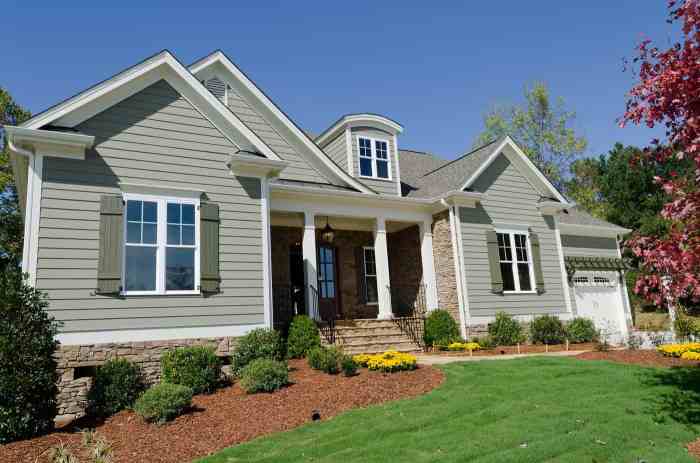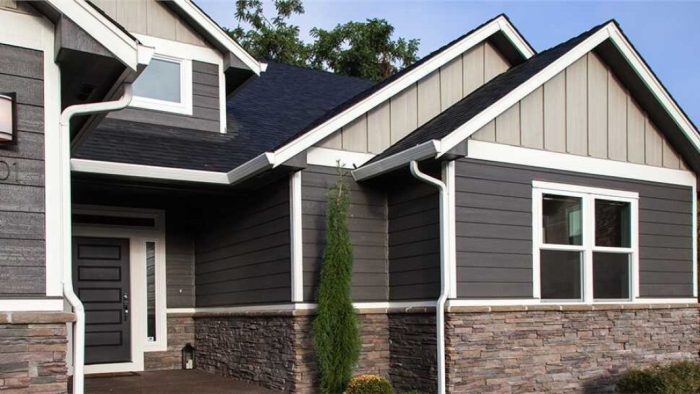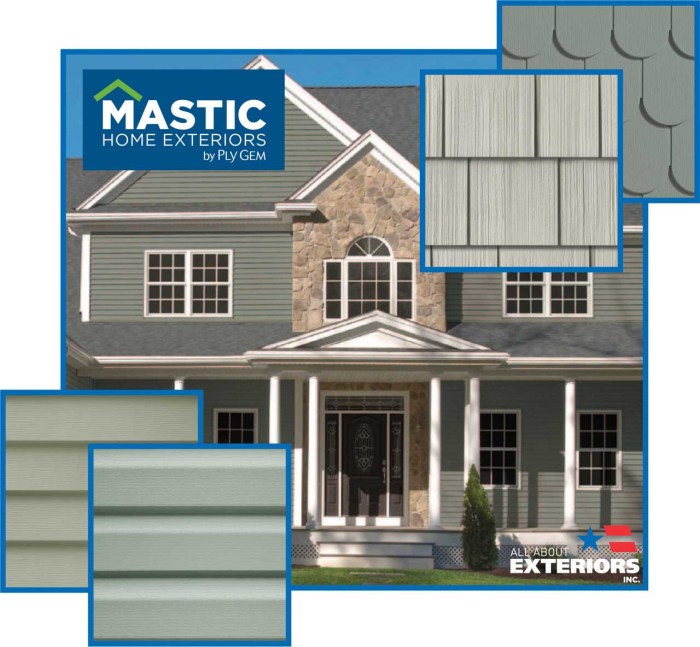As siding contractors near me take the spotlight, this opening passage invites readers to delve into a world of expertise and knowledge, promising an informative and engaging read.
The following paragraph will provide a detailed overview of the topic, covering essential aspects related to siding contractors near me.
Research on Siding Materials
When it comes to choosing siding materials for your home, there are several options available. Each material has its own set of pros and cons, as well as different durability and maintenance requirements.
Vinyl Siding
- Pros: Affordable, low maintenance, wide range of colors and styles available.
- Cons: Can crack or fade over time, not as environmentally friendly as other materials.
- Durability: Typically lasts 20-40 years with proper maintenance.
- Maintenance: Requires occasional cleaning to prevent mold and mildew buildup.
Wood Siding
- Pros: Natural look, can be painted or stained, environmentally friendly.
- Cons: Higher maintenance, susceptible to rot and pests.
- Durability: Depending on the type of wood, can last 20-30 years or more with proper care.
- Maintenance: Regular painting or staining, as well as inspections for rot and insect damage.
Fiber Cement Siding
- Pros: Durable, fire-resistant, low maintenance.
- Cons: More expensive than vinyl or wood, can be heavy to install.
- Durability: Can last 50 years or more, resistant to rot and pests.
- Maintenance: Periodic inspections for cracks or damage, occasional cleaning.
Metal Siding
- Pros: Very durable, low maintenance, can be recycled.
- Cons: Can dent or scratch, limited color options.
- Durability: Can last 40-60 years or more, depending on the type of metal.
- Maintenance: Regular inspections for damage, occasional cleaning to prevent corrosion.
Finding Local Siding Contractors

When looking for siding contractors near your location, it's essential to consider several factors to ensure you hire a reputable and reliable professional for the job.
Effective Ways to Search
- Ask for recommendations from friends, family, or neighbors who have had siding work done recently.
- Check online platforms like Yelp, Angie's List, or the Better Business Bureau for reviews and ratings of local siding contractors.
- Visit home improvement stores in your area and ask for referrals from staff members.
- Contact your local Chamber of Commerce or building associations for a list of recommended siding contractors.
Evaluating Credibility and Reputation
- Check the contractor's website and social media profiles for testimonials, before-and-after photos, and project portfolios.
- Inquire about the contractor's experience, certifications, and training in siding installation.
- Ask for references from past clients and follow up with them to inquire about their experience working with the contractor.
- Verify the contractor's license, insurance coverage, and bonding to ensure they meet the necessary requirements.
Importance of Checking Licenses, Insurance, and References
It is crucial to verify a siding contractor's licenses, insurance, and references before hiring them to protect yourself and your property. A licensed contractor ensures they have met the required standards and regulations for the job. Insurance coverage protects you from liability in case of accidents or damages during the project.
Checking references allows you to gauge the contractor's reliability and quality of work based on past clients' experiences.
Cost Estimation for Siding Projects

When planning a siding project, it is essential to have a clear understanding of the factors that influence the overall cost. From materials to labor and additional services, several elements can impact the total expenses. Here, we will break down the typical costs associated with siding installation or replacement and discuss ways to get accurate estimates from siding contractors.
Factors Influencing Cost
- The type of siding material chosen plays a significant role in determining the cost. Materials such as vinyl, wood, fiber cement, and metal have varying price points.
- The size of the project area is another crucial factor. Larger homes or buildings will require more materials and labor, leading to higher costs.
- The complexity of the project, including any unique design features or intricate patterns, can also impact the overall expenses.
- Additional services like insulation, removal of old siding, or repairs to the underlying structure will add to the total cost.
Breakdown of Costs
| Cost Component | Average Cost Range |
|---|---|
| Siding Materials | $1
|
| Labor Costs | $40
|
| Additional Services | Varies based on requirements |
Getting Accurate Estimates
- Request quotes from multiple siding contractors to compare prices and services offered.
- Provide detailed information about the project scope, including measurements, materials desired, and any specific requirements.
- Avoid choosing the lowest bid without considering the quality of materials and workmanship offered.
- Ask for references and check online reviews to ensure the contractor has a good reputation for delivering quality results.
Siding Installation Process

When it comes to siding installation, there are several general steps that contractors follow to ensure a successful outcome. Proper preparation and site inspection are crucial before starting the installation to avoid any potential issues down the line.
General Steps in Siding Installation
- 1. Preparation of the Site: This involves clearing the area around the house, removing any obstacles that may hinder the installation process.
- 2. Measurement and Siding Selection: Accurate measurements are taken to determine the amount of siding needed, followed by selecting the appropriate siding material based on the homeowner's preference and budget.
- 3. Removal of Old Siding (if applicable): If there is existing siding, it needs to be removed carefully to prepare the surface for the new siding installation.
- 4. Installation of Vapor Barrier: A vapor barrier is installed to protect the house from moisture and prevent water damage.
- 5. Installation of Siding Panels: The siding panels are then installed according to the manufacturer's instructions, ensuring a proper fit and alignment.
- 6. Sealing and Finishing: Once the siding panels are in place, they are sealed, and finishing touches are added to enhance the appearance and durability of the siding.
Common Challenges and Solutions
- 1. Weather Conditions: Unpredictable weather can pose a challenge during siding installation. Contractors may need to reschedule or take additional precautions to ensure the work is done correctly.
- 2. Structural Issues: Discovering structural issues during the installation process can delay the project. Contractors work with homeowners to address these issues before proceeding with the installation.
- 3. Material Defects: Sometimes, defects in the siding material can be encountered. Contractors work with suppliers to replace any defective materials and ensure the installation is completed without any compromises.
Importance of Proper Preparation and Site Inspection
Proper preparation and site inspection play a crucial role in the success of a siding installation project. By conducting a thorough inspection and preparing the site adequately, contractors can identify any potential issues beforehand and address them proactively. This helps ensure that the installation process runs smoothly, minimizing delays and ensuring a high-quality end result that meets the homeowner's expectations.
Maintenance Tips for Siding
Maintaining your siding is crucial to ensure its longevity and keep your home looking its best. By following some simple maintenance tips, you can preserve the beauty and functionality of your siding for years to come.
Regular Cleaning and Inspection
- Regularly clean your siding with a mild detergent and water to remove dirt, grime, and mildew buildup.
- Inspect your siding for any signs of damage, such as cracks, holes, or warping, and address them promptly to prevent further issues.
- Trim any vegetation near your siding to prevent damage from branches or vines rubbing against it.
Maintenance for Different Siding Materials
Each type of siding material requires specific maintenance to ensure its durability and appearance:
| Siding Material | Maintenance Tips |
|---|---|
| Vinyl Siding | Regularly wash with a garden hose and mild detergent. Avoid using harsh chemicals that can damage the vinyl. |
| Wood Siding | Apply a fresh coat of paint or sealant every few years to protect the wood from moisture and rot. |
| Fiber Cement Siding | Inspect for any cracks or chips and repair them with caulk or paint to prevent water infiltration. |
Signs of Damage and When to Repair or Replace
- Look out for signs of rot, mold, or pest infestation, as these indicate serious damage that may require immediate attention.
- If your siding is severely damaged or has reached the end of its lifespan, it may be time to consider replacing it to prevent further issues.
- Small repairs, such as patching up minor cracks or holes, can help prolong the life of your siding if done in a timely manner.
Closure
In conclusion, this guide has shed light on the key factors to consider when searching for siding contractors near me, equipping readers with valuable insights for their next home improvement project.
FAQ Corner
How do I find reputable siding contractors near me?
To find reputable siding contractors near you, ask for recommendations from friends or family, check online reviews, and verify their licenses and insurance.
What are the typical costs associated with siding installation?
The costs of siding installation can vary based on factors like the type of material, size of the project, and labor costs. On average, homeowners can expect to pay between $5,000 to $15,000.
When should I consider repairs or replacements for damaged siding?
If you notice signs of damage such as cracks, warping, or moisture issues, it's advisable to contact a siding contractor for an assessment. They can determine if repairs are sufficient or if replacement is necessary.